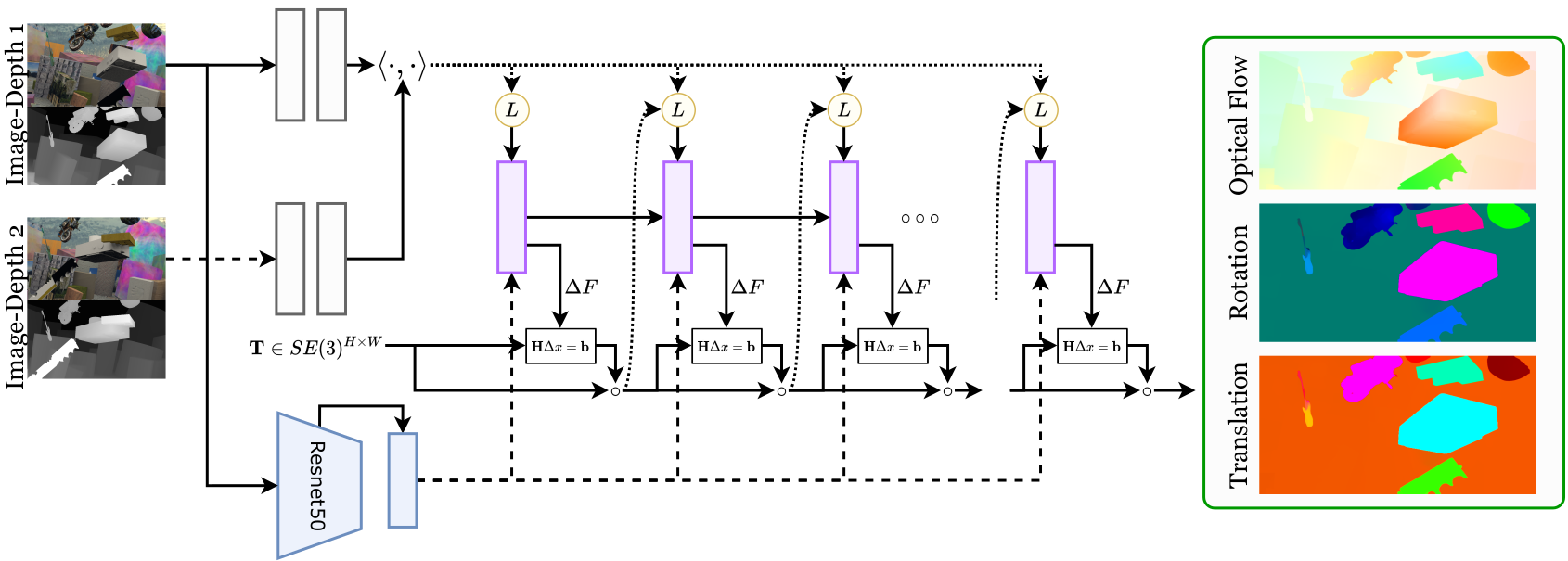RAFT-3D: Scene Flow using Rigid-Motion Embeddings
Zachary Teed and Jia Deng, CVPR 2021
@inproceedings{teed2021raft3d,
title={RAFT-3D: Scene Flow using Rigid-Motion Embeddings},
author={Teed, Zachary and Deng, Jia},
booktitle={Proceedings of the IEEE/CVF Conference on Computer Vision and Pattern Recognition (CVPR)},
year={2021},
}
RAFT-3D requires our LieTorch package to be installed. Please see https://github.com/princeton-vl/lietorch for instructions (requires PyTorch >= 1.6). All Cuda kernels required for RAFT-3D will automatically be installed with LieTorch.
- OpenCV
- matplotlib
- tqdm
- Scikit-Sparse (only required for raft3d_laplacian)
- raft3d.pth : trained on FlyingThings3D
- raft3d_laplacian.pth : trained on FlyingThings3D with bi-Laplacian smoothing
- raft3d_kitti.pth : finetuned on KITTI-15 with bi-Laplacian smoothing
You can run the demo to predict a SE3 field from a pair of RGB-D frames
python scripts/demo.py --network=raft3d.raft3d --model=raft3d.pth
or using the network with bi-Laplacian smoothing
python scripts/demo.py --network=raft3d.raft3d_bilaplacian --model=raft3d_laplacian.pth
Evaluation requires the FlyingThings3D dataset to be downloaded. You also need to download the preprocessed FlowNet3D testing data from things_test_data.pickle.
Our code expects the following directory structure:
├── datasets
├── things_test_data.pickle
├── FlyingThings3D
├── frames_cleanpass
├── frames_finalpass
├── disparity
├── disparity_change
├── optical_flow
├── camera_dataYou can then evaluate one of the pretrained models
python scripts/evaluation.py --network=raft3d.raft3d --model=raft3d.pth
python scripts/evaluation.py --network=raft3d.raft3d_bilaplacian --model=raft3d_laplacian.pth
First download the KITTI Scene Flow dataset. You also need to download disparity estimates from GA-Net disp_ganet_training and disp_ganet_testing. Place the GA-Net estimates in the respective training and testing folders such that the directory structure is as follows
├── datasets
├── KITTI
├── devkit
├── training
├── disp_ganet_training
...
├── testing
├── disp_ganet_testing
...
You can then run the KITTI submission script
python scripts/kitti_submission.py --network=raft3d.raft3d_bilaplacian --model=raft3d_kitti.pth
Training requires a GPU with 24Gb of memory. First download the required datasets for training and evaluation.
python -u scripts/train_things.py --name=r3d --batch_size=4 --lr=0.0002 --network=raft3d.raft3d_bilaplacian
python -u scripts/train_kitti.py --name=r3d_kitti --batch_size=4 --lr=0.0001 --network=raft3d.raft3d_bilaplacian --ckpt=checkpoints/r3d_200000.pth
You can create a submission to the KITTI benchmark by running
python scripts/kitti_submission.py --model=checkpoints/r3d_kitti_050000.pth --network=raft3d.raft3d_bilaplacian
